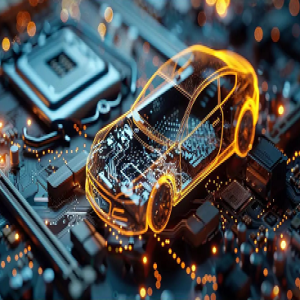Driverless technology: Sensors contribute to traffic safety

As a new member of the modern transportation system, driverless technology is quietly changing the way we travel. In the intelligent system of driverless cars, sensors play a crucial role. By accurately sensing the surrounding environment, sensors improve traffic safety and allow driverless technology to develop faster! Let's take a closer look at how sensors work and are used to see how important they are in driverless technology.
1. Type and function of sensor
Driverless cars are generally equipped with a variety of sensors, such as lidar, millimeter-wave radar, cameras, ultrasonic sensors, etc. Each sensor has its own characteristics and uses, can sense the surrounding environment.
Lidar: This device produces a highly accurate three-dimensional image of the surrounding environment by firing a laser beam and receiving the signal reflected. It's called precision distance and can identify things as small as a few centimeters. And its 360-degree vision allows the driverless car to keep an eye on the surrounding obstacles at all times, making driving safer!
Millimeter wave radar: Millimeter wave radar is the use of electromagnetic wave reflection principle, can measure the distance and relative speed between the vehicle and other objects. Even if the weather is bad, such as rain, fog, snow, it can still perform well, can cut off these disturbances, but also can keep an eye on other vehicles and pedestrians in real time, providing an important basis for the driverless system to make decisions.
Cameras: Cameras are the "eyes" of driverless cars, specifically responsible for recognizing traffic signs, lane lines, and pedestrians. Through image processing technology, the camera can clearly analyze the road situation to help the car navigate and make decisions. When multiple cameras are used together, the field of view is wider and the perception of the environment is more detailed.
Ultrasonic sensors: These ultrasonic sensors are mainly used for close detection, such as parking assistance systems. When the car is moving slowly, it can pay attention to the proximity of things around it in real time, and if it is about to encounter an alarm, it can ensure that it can stop safely.
2. Sensor coordination mode
In order to fully and accurately touch complex traffic environments, these sensors cannot work alone and must be built into an environment awareness system for driverless cars in a highly collaborative manner. In this system, each sensor realizes information sharing through data fusion technology, and also realizes their own shortcomings. Lidar provides high-precision range information, cameras are responsible for observing and identifying objects, millimeter-wave radar provides speed and direction data, and ultrasonic sensors detect short-range obstacles. In this way, through the collaboration of multiple sensors, driverless cars can stably identify important information such as cars, people, traffic signals, and road markings around them under various environmental conditions.
3. How can sensors improve traffic safety
Traffic safety is one of the core goals of driverless technology, and that's where sensors come in! Here are a few ways sensors can improve traffic safety in different situations.
Collision avoidance technology: Through a combination of millimeter-wave radar and lidar, driverless cars can keep an eye on the traffic ahead in real time and identify the risk of a possible collision. If you find yourself about to crash, the car will react immediately by either braking or getting out of the way. In this way, there will be fewer traffic accidents!
Pedestrian recognition and avoidance: In the city, the sudden appearance of pedestrians and bicycles is a big safety hazard. With the cooperation of cameras and lidar, driverless cars can accurately identify the location and movement of pedestrians and make quick judgments and reactions. This not only keeps pedestrians safe, but also makes drivers feel more comfortable.
Navigation and route planning: Sensors provide real-time environmental data to help driverless cars navigate intelligently. Cars can adjust their routes at any time according to road conditions and the status of traffic lights, avoiding congestion and dangerous places. You'll have fewer accidents, and you'll drive more efficiently.
Environmental adaptability: Different environmental conditions have a significant impact on traffic safety. Rainy days, snow days, fog this bad weather, will make the driving line of sight and the performance of the car affected. With sensors such as millimeter wave radar and lidar, driverless cars can maintain awareness of their environment in all kinds of weather, making driving safer.
4. Future motivation
With the continuous progress of technology, the application of sensors in driverless cars will be more and more extensive and in-depth. The cost of liDAR is slowly falling, millimeter wave radar and camera technology continues to innovate, sensor fusion technology is maturing, and more new types of sensors are expected to be added to the perception system of driverless cars in the future.
New sensor technologies, such as multimodal data fusion of vision sensors, can improve the accuracy of environmental recognition and make driving safer. The application of these cutting-edge technologies such as quantum dot sensors and optical flow sensors will greatly improve the intelligent level of unmanned driving and provide a more reliable guarantee for traffic safety.
您可能感興趣的產品
 |
TPCM-2.4-5 | CMC 2.41MH 5A 2LN TH | 6894 More on Order |
 |
62035-P2S02 | XFRMR TOROIDAL 7VA CHAS MOUNT | 6642 More on Order |
 |
62034-P2S02 | XFRMR TOROIDAL 7VA CHAS MOUNT | 7938 More on Order |
 |
62025-P2S02 | XFRMR TOROIDAL 5VA CHAS MOUNT | 3924 More on Order |
 |
62021-P2S02 | XFRMR TOROIDAL 5VA CHAS MOUNT | 5058 More on Order |
 |
62005-P2S02 | XFRMR TOROIDAL 1.6VA CHAS MOUNT | 7668 More on Order |
 |
62073-P2S02 | XFRMR TOROIDAL 35VA CHAS MOUNT | 5292 More on Order |
 |
70054K | XFRMR TOROIDAL 15VA THRU HOLE | 4716 More on Order |
 |
70043K | XFRMR TOROIDAL 10VA THRU HOLE | 5562 More on Order |
 |
70041K | XFRMR TOROIDAL 10VA THRU HOLE | 2826 More on Order |
 |
70024K | XFRMR TOROIDAL 5VA THRU HOLE | 8748 More on Order |
 |
70014K | XFRMR TOROIDAL 3.2VA THRU HOLE | 5562 More on Order |
 |
70013K | XFRMR TOROIDAL 3.2VA THRU HOLE | 4392 More on Order |
 |
70003K | XFRMR TOROIDAL 1.6VA THRU HOLE | 2520 More on Order |
 |
70002K | XFRMR TOROIDAL 1.6VA THRU HOLE | 5040 More on Order |
 |
62015-P2S02 | XFRMR TOROIDAL 3.2VA CHAS MOUNT | 3780 More on Order |
 |
62082-P2S02 | XFRMR TOROIDAL 50VA CHAS MOUNT | 4986 More on Order |
 |
62033-P2S02 | XFRMR TOROIDAL 7VA CHAS MOUNT | 6480 More on Order |
 |
70064K | XFRMR TOROIDAL 25VA THRU HOLE | 13758 More on Order |
 |
70034K | XFRMR TOROIDAL 7VA THRU HOLE | 8088 More on Order |
 |
70005K | XFRMR TOROIDAL 1.6VA THRU HOLE | 7218 More on Order |
 |
AC1050 | CURR SENSE XFMR 50A T/H | 7362 More on Order |
 |
AC1015 | CURR SENSE XFMR 15A T/H | 5166 More on Order |
 |
AC1025 | TRANSFORMER CURRENT 25.0 AMP | 4230 More on Order |









